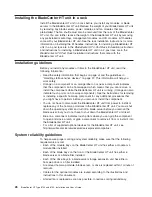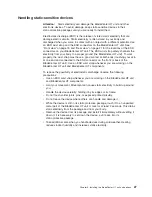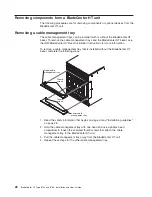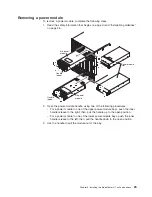
blade
server
requires
attention,
the
location
LED
on
the
blade
server
usually
will
also
be
lit.
After
the
BladeCenter
HT
unit
has
been
located,
you
can
have
the
system
administrator
turn
off
the
location
LED.
v
Critical
system
fault:
When
this
LED
is
lit,
the
BladeCenter
HT
unit
has
a
critical
system
fault.
A
critical
system
fault
is
an
error
or
event
that
is
detected
by
the
system
with
a
significant
impact
to
the
system.
In
this
case,
the
system
cannot
continue
to
operate
or
is
operating
in
a
non-redundant
power
configuration
or
a
non-redundant
cooling
configuration.
Note:
The
color
of
this
LED
can
be
set
to
amber
or
red
through
the
advanced
management
module.
v
Major
system
fault:
When
this
LED
is
lit,
the
BladeCenter
HT
unit
has
a
major
system
fault.
The
system
can
continue
to
operate
but
may
loose
some
functionality
and
performance.
Note:
The
color
of
this
LED
can
be
set
to
amber
or
red
through
the
advanced
management
module.
v
Minor
system
fault:
When
this
amber
LED
is
lit,
the
BladeCenter
HT
unit
has
a
minor
system
fault.
The
system
can
continue
to
operate,
usually
without
noticeable
loss
of
functionality
or
performance.
v
FRU
ready
for
removal:
When
this
blue
LED
is
lit,
it
is
safe
to
remove
the
device
from
the
BladeCenter
HT
unit.
v
Alarm
panel
module
fault:
When
this
amber
LED
is
lit,
there
is
a
fault
on
the
alarm
panel
module.
The
system
can
continue
to
operate,
usually
without
the
use
of
the
components
on
the
alarm
panel
module.
v
Serial
connector:
This
DB60
connector
provides
direct
access
to
the
serial
ports
on
each
of
the
12
blade
server
bays.
Use
this
connector
to
attach
the
optional
serial
port
breakout
cable
and
connect
up
to
12
local
consoles.
See
the
documentation
that
comes
with
your
blade
server
to
determine
if
it
supports
this
cable.
v
Telco
alarm
connector:
The
alarm
panel
module
provides
one
DB15
connector
(male)
for
critical,
major,
and
minor
telco
alarms.
Each
of
the
alarms
has
a
relay
that
enables
multiple
system
alarm
indicators
to
be
daisy-chained
together.
The
following
table
shows
the
pinouts
for
the
alarm
panel
interface
connector.
Pin
#
Description
Input/Output
signal
1
Minor
alarm
reset
+
Input
2
Minor
alarm
reset
-
Input
3
Major
alarm
reset
+
Input
4
Major
alarm
reset
-
Input
5
Critical
alarm
normally
open
Output
6
Critical
alarm
normally
closed
Output
7
Critical
alarm
common
Output
8
Minor
alarm
normally
open
Output
9
Minor
alarm
normally
closed
Output
10
Minor
alarm
common
Output
11
Major
alarm
normally
open
Output
12
Major
alarm
normally
closed
Output
13
Major
alarm
common
Output
Chapter
2.
BladeCenter
HT
unit
power,
components,
and
indicators
23
Summary of Contents for 87401RU
Page 3: ...BladeCenter HT Type 8740 and 8750 Installation and User s Guide...
Page 8: ...vi BladeCenter HT Type 8740 and 8750 Installation and User s Guide...
Page 82: ...66 BladeCenter HT Type 8740 and 8750 Installation and User s Guide...
Page 92: ...76 BladeCenter HT Type 8740 and 8750 Installation and User s Guide...
Page 108: ...92 BladeCenter HT Type 8740 and 8750 Installation and User s Guide...
Page 109: ......
Page 110: ...Part Number 44R5188 Printed in USA 1P P N 44R5188...
















































